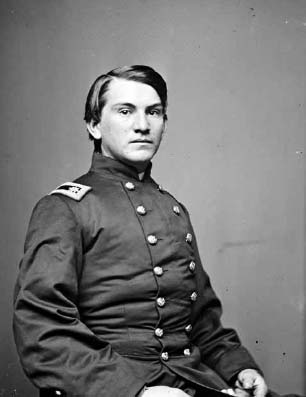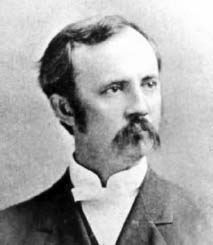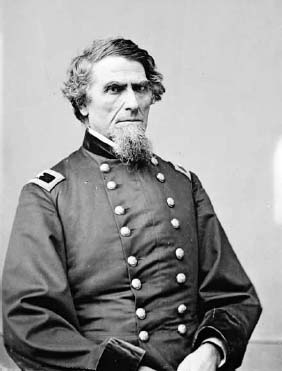The Battle of White Sulphur Springs (5 page)
Read The Battle of White Sulphur Springs Online
Authors: Eric J. Wittenberg


Major Thomas Gibson, commander of Gibson's Independent Battalion.
Library of Congress
.
Major Thomas Gibson Jr., age thirty-one, commanded Averell's Independent Cavalry Battalion. His father was the surveyor of the Port of Pittsburgh during the administration of President James Buchanan and also served as colonel of one of Pennsylvania's militia regiments. His mother came from a line of wealthy foundry owners, so he had a privileged life. Gibson was a graduate of Pittsburgh's Western University and was known as “a gentleman of culture and ability.” One of his former soldiers remembered him as “always ready for a fight.”
56
Another said that he had “inherited the Irish courage and daring.”
57
He was originally commissioned captain of Company D of the 2
nd
West Virginia Infantry and was promoted to major of the regiment in July 1862. He resigned that commission in November 1862 to accept a commission as major of the 14
th
Pennsylvania Cavalry.
58
By the summer of 1863, Gibson led a hodgepodge command composed of four companies of the 3
rd
West Virginia Cavalry, Captain Frederick Schambeck's Company C (known as the Chicago Dragoons) of the 16
th
Illinois Cavalry and the 3
rd
Independent Company Ohio Cavalry, raised in Cincinnati and known for “the energy and success with which it performed the work of scouting and screening.”
59
The battalion was organized in Pittsburgh in June 1863 and was immediately assigned to join Averell's Fourth Separate Brigade.
60

Captain Chatham T. Ewing, commander of Battery G, 1
st
West Virginia Light Artillery, shown in civilian attire.
Francis S. Reader
, History of the Fifth West Virginia Cavalry.
Captain Chatham T. Ewing commanded Battery G, 1
st
West Virginia Light Artillery. Ewing was born on January 30, 1839, near New Lisbon, Ohio. In 1852, his family moved to Pittsburgh. He became a member of the Pittsburgh Zouaves, an infantry militia company, in the summer of 1860. He was a tax collector and also studied law and was admitted to the bar in the winter of 1861; he had just started his own practice in Pittsburgh when war came. Known as “a splendid officer and a gentleman of culture,” Ewing was commissioned captain of Battery G on August 2, 1861. Averell later described him as “an active, brave, and efficient artillery officer.” The well-liked artillerist's battery consisted of two sections of two guns each, manned by western Pennsylvanians. The battery served with Frémont and Pope and then returned to West Virginia. Its men were veterans and were reliable.
61
Captain Paul Freiherr von König, a German adventurer, commanded the detachment of the 68
th
New York assigned to serve with Averell's brigade. The twenty-three-year-old König, a baron and a member of an ancient ennobled family from Brunswick in Germany, had joined Averell's staff shortly before the Stoneman Raid and had remained there when Averell was sent to West Virginia. A small detachment of his regiment, the 68
th
New York, served with the Fourth Separate Brigade as a signal detachment. The precise size and makeup of this detachment is unknown, as it has not been documented. Baron von König's story is told in detail in
Appendix B
.
Once the decision to mount these men was made, Major General Robert Schenck, the commander of the Middle Military District, which included Averell's command, ordered the purchase of horses for the Fourth Separate Brigade. They were procured from Pittsburgh; Wheeling; Gallipolis, Ohio; and from the counties in the vicinity of the railroad running from Grafton to Parkersburg. In the rush to acquire sufficient mounts for the infantry regiments, any nag was purchased, meaning that the horses provided were of uneven quality.
Part of Averell's brigade was armed with an unusual weapon, the Lindner carbine. The Lindner carbine was a single-shot, .56-caliber breech-loading weapon that required a cartridge and an ordinary percussion cap. Approximately 501 guns and 100,000 cartridges were purchased by the War Department in December 1862 and were then issued to Averell's command, mostly to members of the 8
th
West Virginia.
62
The remainder of the Fourth Separate Brigade either received similar breech-loaders or their existing weapons were modified to fit them for mounted service. Averell then established a camp of instruction at Bridgeport, near Clarksburg, and on June 6, he sent the 3
rd
West Virginia there to drill. On June 9, he ordered the 8
th
West Virginia to go there as well. Horses were issued, but the necessary accoutrements were not sent with them. While waiting for the equipment to arrive, Averell instructed the officers in cavalry tactics.
63
On June 15, the equipment finally arrived, along with orders to move to reinforce the Union command at New Creek, West Virginia, which was being threatened by the advance of General Robert E. Lee's Army of Northern Virginia, which was then in the process of invading Pennsylvania. The 14
th
Pennsylvania Cavalry met up with and joined the brigade on July 2, and the Fourth Separate Brigade helped to repulse a probe toward Beverly in Randolph County by the 19
th
Virginia Cavalry on July 4. After blunting the Confederate foray, Averell received orders to march his command to Webster, West Virginia, where it was entrained on the Baltimore & Ohio Railroad and transported to Cumberland to assist in trying to capture Lee's
army
, which was retreating from its defeat in Pennsylvania.
64
These men were especially well suited to the travails that awaited them. “Averell's men were mountain bred and they took to the excursions that he laid out for them as to the manner born,” observed one historian. “Where other commanders had made little circles like the rabbit, the army of Averell swung wide like the red fox. A thousand miles was just a pleasure jaunt for the Fourth Brigade.”
65
Averell received orders to advance from Cumberland to Hancock, Maryland, and arrived there on July 13 after a grueling fifty-mile march through rain and muddy, almost impassable, roads. His men then marched from Hancock to Williamsport, where they joined the main body of the Army of the Potomac about eleven o'clock that night. Averell and his brigade were in line and in position in time for its general advance on July 14. However, Lee's army had already slipped across the Potomac River to safety. The West Virginians missed their chance for glory when Lee's army escaped. However, other chances lay just ahead.
66
When word came that Lee's army was retreating up the Shenandoah Valley toward Staunton, Averell received orders to return to the Martinsburg area. After sending patrols as far south as Winchester, Averell then received orders to march his command to Beverly, where it rested for a few days.
67
It needed that brief respiteâa great adventure lay in store for Averell and his ragtag band.
2
For Want of a Nail
On August 5, Averell and his command of about fourteen hundred men left Winchester and marched twenty-eight miles over North Mountain to Wardensville. He had his entire brigade, less the 2
nd
West Virginia, with him. The Yankee horse soldiers passed through a gap in North Mountain west of Winchester and then moved into the Capon Valley.
68
The daring and intrepid Captain Paul von König, who led the brigade's way with a detachment of scouts, captured a captain and ten enlisted men and commissary supplies of Brigadier General John D. Imboden's Confederate cavalry brigade along the way. After resting for a few hours, the Fourth Separate Brigade covered another thirty miles on August 6, arriving at Moorefield at about eight thirty that night. That day, a detachment of the 14
th
Pennsylvania Cavalry was sent ahead to Moorefield via Harper's Mills. The Pennsylvanians captured a Confederate lieutenant and a few enlisted men. However, they fell into an ambush after dark, losing not only the prisoners but also thirteen of their own men captured by the enemy. Four of the Pennsylvanians were wounded, while three Confederates were killed and another five were wounded.
69
The Fourth Separate Brigade spent a couple of days resting at Moorefield after covering nearly sixty miles in just two days. They moved out again on August 9, covering only eleven miles and heading to Petersburg, a small West Virginia town on the South Branch of the Potomac River. “My command was at this time badly in want of horse-shoes and nails, clothing, and ammunition, requisitions for which had been made by my quartermaster, at Cumberland, on the 7
th
,” reported Averell at the end of the raid.
70
Averell decided to remain at Petersburg until the supplies arrived before he went on. And so the Fourth Separate Brigade sat and waited, losing the initiative with each passing day.

Brigadier General Benjamin F. Kelley, commander of the Department of West Virginia.
Library of Congress
.
On August 12, Brigadier General Benjamin F. Kelley, who commanded the Department of West Virginia, sent orders to Averell. Kelley instructed Averell to move, without delay, to march to Huntersville in Pocahontas County, via Franklin in Pendleton County, to the Beverly and Staunton Pike, at or near Monterey, Highland County. Huntersville lay on the HuttonsvilleâWarm Springs road, fifty miles south of Huttonsville and twenty-five miles north of Warm Springs. Upon arriving at Huntersville, Averell was to attack Colonel William L. “Mudwall” Jackson's 19
th
Virginia Cavalry and drive the Southern horsemen out of the county. While passing through Pendleton County, Averell was to destroy the saltpeter and powder works there.
71
Kelley instructed Averell to carry hardtack, sugar and bread and to gather beef and pork from the land along the way. Kelley told the New Yorker to bring along any excess cattle for the use of the army and to give receipts for any supplies foraged from the countryside. Kelley also instructed Averell to impose stringent measures to prevent straggling by his command and also to prevent his troopers from interfering with private property rights along the way.
72
Kelley indicated that he was ordering the 2
nd
and 10
th
West Virginia Infantry to join Averell's command upon his arrival at Huntersville, one of two towns in Randolph County and the county seat. He was to leave the 10
th
West Virginia at Huntersville, while taking the rest of the Fourth Separate Brigade on to Lewisburg to seize the law library of the court of appeals of Virginia stored there and then to bring the books to Beverly. “Great care will be exercised by the officer placed in charge that the books are not lost or injured,” ordered Kelley. Once Averell seized the law library, he was to return to Beverly and report his arrival by telegraph.
73
